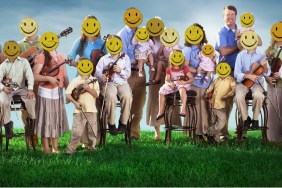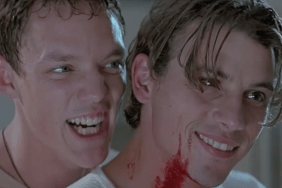
Wes Craven never dreamed of making horror movies.
Having grown up in a fundamentalist home, he had never even seen one, let alone harbored any aspirations of stepping behind the camera for one. The thought only crossed his mind when good friend Sean Cunningham suggested Craven should drag the ghosts of his upbringing out of the closet for his latest production. Craven responded with The Last House on the Left, a film with a grim forecast for Flower Power Americana in the 70s; it wasnt that Craven just insisted that we were no longer safe from intrudersits that he further insinuated that we would have to sacrifice part of our souls along with a pound of flesh to overcome them. Even the stability of the family unit would crumble, its foundation shaken by eruptions of violence blurring the line between sane and insane.
Destructive families would recur throughout Cravens career: The Hills Have Eyes escalates the themes of Last House by pitting an all-American family against a literally post-nuclear one, while the 80s would find him exploring religiously oppressive familial regimes in Deadly Blessing (arguably the most obvious reflection of the directors Baptist upbringing) and uncovering dark, repressed suburban secrets in A Nightmare on Elm Street. For Craven, it seems clear that true horror is a family undone or warped by violence, especially when that violence is instigated by another family.
You have to wonder if The People Under the Stairs is among the most personal of Cravens films. In it, he revisits the theme of families preying on one another, but reimagines it within the context of American class warfare waged in part by fundamentalists. His setting takes a familiar urban legendthe one, spooky house on the block that every child avoidsand couches it in a gritty, modern milieu. Here, the old haunt in question overlooks a Los Angeles ghetto and houses a pair of Bible-thumping maniacs (Everett McGill and Wendy Robie) who exploit their poor (and pointedly minority) tenants.
Wielding gentrification like a weapon, theyve evicted most of the unsavory elements from their property and replaced them with upscale buildings. Their motives are hardly concealed by their casually uncorked racial epithets or their barely coded language: when they fret about the neighborhood changing, theyre obviously referring to the African-American population.

If Craven drew the line here, this duo would be monstrous enough. However, he pushes to more extreme boundaries by further literalizing their monstrosity when a 13-year-old Poindexter Fool Williams (Brandon Adams) discovers their darkest secrets. Rumors that have persisted about the couple for years are confirmed when the black teen breaks into their home under Robin Hood pretenses: upon being coaxed by an older associate (Ving Rhames), he enters his landlords home in search of gold so his cancer-stricken mother can afford surgery. Instead, he only finds repulsion: apparently, the couplewho only refers to themselves rather incestuously as Mommy and Daddyhas imprisoned their daughter Alice (A.J. Langer) for her entire life. Theyve also stowed away a horde of mutilated cannibals beneath their stairs, the discarded remains of a search for a perfect son.
Obviously, the titular monsters are a bit of misdirection, designed to further highlight the grotesqueness of the true boogeymen terrorizing the neighborhood, a reflection of the growing realization that monsters no longer lurk in shadows but operate out in the open. The People Under the Stairs argues they might be your neighbors, or, even more insidiously, avatars of a moral majority that gripped the country in its clutches for over a decade. Plucked straight out of Twin Peaks, McGill and Robie are Neocons taken to their unhinged, cartoonish extreme: with Bible verses in their hearts and a shotgun in their hands, they sit atop a pile of gold and cash like a couple of Scrooge McDucks, hoarding wealth from the less fortunate.
Theyre nightmare versions of Ronald and Nancy Reagan, hypocritically preaching from a pulpit that hides their own vices. News footage of the Gulf War fills a lone television set in the cellar, feeding its inhabitants horrifying images of destruction in an unsubtle swipe at the Reagan-Bush era. While this time periods leaders heralded unearned righteousness from atop a war machine, they sneakily drove a further wedge into Americas class structure by selling the promise that the rich must become richer in order to help the poor.
By 1991, that was an empty gesture, and The People Under the Stairs twists those broken promises and shattered dreams into a comically gruesome horror show. Quaint, Rockwellian images of mom and pop sitting fireside are exaggerated into dear old dad chomping down on human meat, barely taking the time to remove the buckshot form his teeth. Cravens macabre sense of humor has rarely been more potent than it is here, as over-the-top, wild-eyed performances (highlighted by maniacal close-ups) undercut this deranged duo, revealing them to be huffy children beneath their menacing facades. McGills veiny face especially simmers with a petulant rage, while Robie often betrays her put-upon, cockeyed housewife routine with her own fits. Its not enough that Fool escapes these two, as one of the films chief pleasures is watching him completely frustrate and humiliate them first, proving that boogeymen are only as scary as you make them out to be.
Along with Fool and Alice (Mommy and Daddy are especially aghast that their pure, white daughter is teaming up with a black kid, naturally), the audience does endure a claustrophobic nightmare of cluttered, canted camera angles capturing suffocating spaces between the walls and beneath the stairs. The only way out for Fool is through the dark bowels of the place, where he must directly confront the terrors of his oppressors, an act that takes on the tenor of a revolution by films end once his fellow victims finally rise up with him from within the house and without.

Cravens reach in People Under the Stairs is vast, stretching across lines of race and class in revealing a new set of American fears in the 90s. Its a landscape where so manyfrom the poor to the downright weirdhave been cast off under the pretense of a rotten morality. Where Cravens earlier work implied that that rot would spread everywhere, The People Under the Stairs sees the director pointing only to the decayed core, one that must be literally exploded in order for trickle-down economics to actually work.
As gold coins and dollar bills rain down at the conclusion here, the image of family endures; for once, viewers arent left with a disturbing, blood-soaked snapshot but rather with the comforting suggestion that a family canand mustremain intact to survive, thus closing the circle started by The Last House on the Left. In a world turned upside down, our heroes are the invaders here, forced now to claw their way through a house of horrors to reclaim an American Dream thats been warped into an unrecognizable nightmare.
Nearly 25 years later, a rare triumphant ending for Craven feels less so, though the rest of The People Under the Stairs grows ominously prescient: with escalated racial strife and a widened income gap, todays America doesnt feel too far removed from the directors askew but accurate vision from 1991. Because it continues to resonate, The People Under the Stairs (along with Brian Yuznas Society) remains a crucial dispatch from the Reagan-Bush years, as the eras thousand points of light still cast long, sinister shadows.
The Disc:
Scream Factory is firmly in the Wes Craven business this year, as a trio of his films is on deck for Blu-ray treatment, including Shocker and The Serpent and the Rainbow. Arriving first with a Collectors Edition release on August 11th is The People Under the Stairs; less than a year removed from Universals own bare bones offering, this update is a worthwhile wait for fans starved for supplements. While Scream hasnt produced a typical retrospective documentary, two feature commentaries and four separate interviews (totaling over an hour in combined) provide a wealth of insight into the films production.
Joined by moderator Michael Felsher, Craven headlines the first commentary track and discusses the films conception, production, and themes. Felshers questions keep the discussion lively and veer it away from Craven merely commenting about the on-screen action. The other commentary joins Adams, Langer, Sean Whalen, and Yan Birch to reminisce about the films production.

The separate interviews catch up with various cast and crew members, including Robie, whose House Mother featurette has the actress describing the casting process and her experience working with Craven. A nice anecdote towards the end also highlights the films impact across the Atlantic, as it inspired political cartoons in France. House of Horrors gives the spotlight to DP Sandi Sisse, who details the rigorous technical aspects of shooting in confined spaces for the film. FX legends Robert Kurtzman, Greg Nicotero, and Howard Berger discuss their grisly contributions to the film in What Lies Beneath, while composer Don Peake describes the process of replacing parts of original composer Graeme Revells work in the aptly titled Settling the Score.
Bits of other vintage material round out the disc, including a 3-minute EPK package and six minutes of behind-the-scenes footage from one of the films memorably gruesome moments. Storyboards, a stills gallery, a trailer, and some TV spots complete the promotional material.
At one point, Craven was tapped to produce a remake of The People Under the Stairs, but this new edition is a reminder that the original film is as relevant as everif not more so. Thousandsif not millionsof Fools still exist, desperately longing to escape broken neighborhoods haunted by greed and inequality.
—
Brett Gallman is a member of the Online Film Critics Society. He was raised in and around video stores and hasnt stopped talking about horror movies ever since. You can find him on Twitter @brettgallman.









